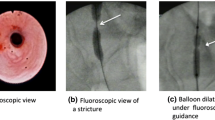Abstract
Purpose
We sought to determine whether preoperative stricture length measurement affected the choice of procedure performed, its correlation to intraoperative stricture length, and postoperative outcomes.
Methods
The Collaborative of Reconstructive Robotic Ureteral Surgery (CORRUS) database was queried for patients undergoing robotic ureteral reconstructive surgery from 2013 to 2021 who had surgical stricture length measurement. From this cohort, we identified patients with and without preoperative stricture length measurement via retrograde pyelogram or antegrade nephrostogram. Outcomes evaluated included intraoperative complications, 30-day complications greater than Clavien-Dindo grade II, hardware-free status, and need for additional procedures.
Results
Of 153 patients with surgical stricture length measurements, 102 (66.7%) had preoperative radiographic measurement. No repair type was more likely to have preoperative measurement. The Pearson correlation coefficient between surgical and radiographic stricture length measurements was + 0.79. The average surgical measurement was 0.71 cm (± 1.52) longer than radiographic assessment. Those with preoperative imaging waited on average 5.0 months longer for surgery, but this finding was not statistically significant (p = 0.18). There was no statistically significant difference in intraoperative complications, 30-day complication rates, hardware-free status at last follow-up, or need for additional procedures between patients with and without preoperative measurement. The only significant predictive factor was preoperative stricture length on 30-day postoperative complications.
Conclusions
Despite relatively high prevalence of preoperative radiographic stricture length measurement, there are few measures where it offers clinically meaningful diagnostic information towards the definitive surgical management of ureteral stricture disease.
Similar content being viewed by others
Data availability
The data that support the findings of this study are available on request from the corresponding author, LCZ.
References
Vasudevan VP, Johnson EU, Wong K et al (2019) Contemporary management of ureteral strictures. J Clin Urol 12:20–31
Abboudi H, Ahmed K, Royle J et al (2013) Ureteric injury: a challenging condition to diagnose and manage. Nat Rev Urol 10:108–115
Zhao LC (2018) Management of ureteral strictures. Rev Urol 20:177–178
Morey AF, Brandes S, Dugi DD et al (2014) Urotrauma: American Urological Association guideline. J Urol 192:327
Kitrey ND, Campos-Juanatey F, Hallscheidt P et al (2022) European Association of Urology Guidelines on Urological Trauma. In: Presented at the EAU Annual Congress Amsterdam March 2022
Elbers JR, Socarras MR, Rivas JG et al (2021) Robotic repair of ureteral structures: techniques and review. Curr Urol Rep 22:39
Nezhat C, Nezhat F, Green B et al (1992) Laparoscopic treatment of obstructed ureter due to endometriosis by resection and ureteroureterostomy: a case report. J Urol 148:865–868
Yohannes P, Chiou RK, Pelinkovic D et al (2003) Pure robot-assisted laparoscopic ureteral reimplantation for ureteral stricture disease: a case report. J Endourol 17:891–893
Drain A, Jun MD, Zhao LC (2021) Robotic ureteral reconstruction. Urol Clin N Am 48:91–101
Lee Z, Simhan J, Parker DC et al (2013) Novel use of indocyanine green for intraoperative, real-time localization of ureteral stenosis during robot-assisted ureteroureterostomy. Urology 82:729
Lee Z, Moore B, Giusto L et al (2015) Use of indocyanine green during robot-assisted ureteral reconstructions. Eur Urol 67:291–298
Shokeir AA, El-Diasty T, Eassa W et al (2004) Diagnosis of ureteral obstruction in patients with compromised renal function: the role of noninvasive imaging modalities. J Urol 171:2303–2306
Zhao LC, Weinberg AC, Lee Z et al (2018) Robotic ureteral reconstruction using buccal mucosa grafts: a multi-institutional experience. Eur Urol 73:419–426
Terlecki RP, Steele MC, Valadez C et al (2011) Urethral rest: role and rationale in preparation for anterior urethroplasty. Urology 77:1477–1481
Funding
No funding was received for conducting this study.
Author information
Authors and Affiliations
Contributions
TRZ: data management and interpretation, manuscript writing, critical review of manuscript. KM: project development, data collection and interpretation, critical review of manuscript. GB: data analysis and interpretation, critical review of manuscript. AA: data management and interpretation, critical review of manuscript. MS: project development, data collection, critical review of manuscript. DE: project development, data collection, critical review of manuscript. LCZ: project development, data collection, critical review of manuscript.
Corresponding author
Ethics declarations
Conflict of interest
The authors have no relevant financial or non-financial interests to disclose.
Ethics approval
Ethics approval was waived by the Institutional Review Board of NYU Langone Medical Center in view of the retrospective nature of the study.
Additional information
Publisher's Note
Springer Nature remains neutral with regard to jurisdictional claims in published maps and institutional affiliations.
Rights and permissions
Springer Nature or its licensor (e.g. a society or other partner) holds exclusive rights to this article under a publishing agreement with the author(s) or other rightsholder(s); author self-archiving of the accepted manuscript version of this article is solely governed by the terms of such publishing agreement and applicable law.
About this article
Cite this article
Zhang, T.R., Mishra, K., Blasdel, G. et al. Preoperative stricture length measurement does not predict postoperative outcomes in robotic ureteral reconstructive surgery. World J Urol 41, 2549–2554 (2023). https://doi.org/10.1007/s00345-023-04525-6
Received:
Accepted:
Published:
Issue Date:
DOI: https://doi.org/10.1007/s00345-023-04525-6




